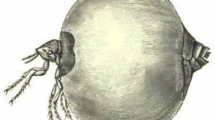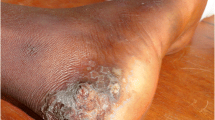Abstract.
Tungiasis is an important health problem in poor communities in Brazil and is associated with severe morbidity, particularly in children. The causative agent, the female flea Tunga penetrans, burrows into the skin of its host, where it develops, produces eggs and eventually dies. From the beginning of the penetration to the elimination of the carcass of the ectoparasite by skin repair mechanisms, the whole process takes 4–6 weeks. The present study is based on specimens from 86 patients, for some of whom the exact time of penetration was known. Lesions were photographed, described in detail and biopsied. Biopsies were examined histologically and by means of scanning electron microscopy (SEM). Based on clinical, SEM and histological findings, the "Fortaleza classification" was elaborated. This allows the natural history of tungiasis to be divided into five stages: (1) the penetration phase, (2) the phase of beginning hypertrophy, (3) the white halo phase, (4) the involution phase and (5) residues in the host's skin. Based on morphological and functional criteria, stages 3 and 4 are divided into further substages. The proposed Fortaleza classification can be used for clinical and epidemiological purposes. It allows a more precise diagnosis, enables the assessment of chemotherapeutic approaches and helps to evaluate control measures at the community level.




















Similar content being viewed by others
References
Ade-Serrano MA, Olomolehin OG, Adewunmi A (1982) Treatment of human tungiasis with niridazole (Ambilhar): a double-blind placebo-controlled trial. Ann Trop Med Parasitol 76:89–92
Cardoso A (1981) Generalized tungiasis treated with thiabendazole. Arch Dermatol 117:127
Connor DH (1976) Diseases caused by arthropods—tungiasis. In: Binford CH, Connor DH (eds) Pathology of tropical and extraordinary diseases. Armed Forces Institute of Pathology, Washington, D.C., pp 610–614
Cooper JE (1967) An outbreak of Tunga penetrans in a pig herd. Vet Rec 80:365–366
Feldmeier H, Eisele M, Heukelbach J, Saboia Moura RC (2003) Severe tungiasis—a resurgent health problem in deprived populations? A case series from Northeast Brazil (manuscript submitted)
Feldmeier H, Heukelbach J, Eisele M, Carvalho CBM (2002b) Bacterial superinfection in human tungiasis. Trop Med Int Health 7:559–564
Franck S, Wilcke T, Feldmeier H, Heukelbach J (2003) Tungiasis bei Tropenreisenden: eine kritische Bestandsaufnahme. (in press)
Geigy R, Herbig A (1949) Die Hypertrophie der Organe beim Weibchen von Tunga penetrans. Acta Trop 6:246–262
Guerra F (1968) Aleixo de Abreu [1568–1630], author of the earliest book on tropical medicine describing amoebiasis, malaria, typhoid fever, scurvy, yellow fever, draconiasis, trichuriasis and tungiasis in 1623. J Trop Med Hyg 71:55–69
Heukelbach J, Oliveira FAS, Hesse G, Feldmeier H (2001) Tungiasis: a neglected health problem of poor communities. Trop Med Int Health 6:267–272
Heukelbach J, Wilcke T, Eisele M, Feldmeier H (2002) Ectopic localization of tungiasis. Am J Trop Med Hyg 67:214–216
Jacobs W, Renner M (1988) Biologie und Ökologie der Insekten. Fischer, Stuttgart
Karsten H (1865) Beitrag zur Kenntnis des Rhynchoprion penetrans. Virchows Arch Pathol Anat Physiol 32:269–292
Lavoipierre MMJ, Radovsky FJ, Budwiser PD (1979) The feeding process of a tungid flea, Tunga monositus (Siphonaptera: Tungidae), and its relationship to the host inflammatory and repair response. J Med Entomol 15:187–217
Linardi PM (2000) Família Tungidae. In: Linardi PM, Guimaraes LR (eds) Sifonápteros do Brasil, 1st edn. Museu de Zoologia da Universidade de São Paulo, São Paulo, pp 48–53
Mehlhorn H (2001a) Enyclopedic references of parasitology, vol 1. Springer, Berlin Heidelberg New York
Mehlhorn H (2001b) Enyclopedic references of parasitology, vol 2. Springer, Berlin Heidelberg New York
Mehlhorn B, Mehlhorn M, Plötz J (2002) Light and scanning electron microscopical study on Antarctophthiosis ogmorhini-lice from the Antarctic seal Leptonychotes weddelli. Parasitol Res 88:651–660
Rey L (1992) Bases da parasitologia médica. Guanabara Koogan, Rio de Janeiro, pp 304–310
Rietschel W (1989) Beobachtungen zum Sandfloh (Tunga penetrans) bei Mensch und Hund in Französisch-Guayana. Tieraerztl Prax 17:189–193
Saraceno EF, Bazarra MLG, Calviello RC et al (1999) Tungiasis: tratamiento de un caso con ivermectina. Arch Argent Dermatol 49:91–95
Schimkewitsch W (1884) Zur Frage nach der Veränderung der Sarcopsylla penetrans unter dem Einflusse des Parasitismus. Virchows Arch Pathol Anat Physiol 52:673–676
Vaz Z, Rocha UF (1946) Tunga penetrans (L., 1758), "bicho de pé" em gado bovino. Livro de Homenagem a R.F. Almeida 40:327–332
Wilcke T, Heukelbach J, Cesar Saboia MR, Regina SK-P, Feldmeier H (2002) High prevalence of tungiasis in a poor neighbourhood in Fortaleza, Northeast Brazil. Acta Trop 83:255–258
Acknowledgements.
This study was supported in part by the Ärztekomittee für die Dritte Welt, Frankfurt (Germany), the World Health Organization (Grant CPE/PVC B2/181/195), Geneva (Switzerland), Bayer Environmental Science and Animal Health, Leverkusen (Germany), Merck do Brasil, Rio de Janeiro (Brazil), and Laboratórios Sintofarma S.A., São Paulo (Brazil). The following individuals contributed with private donations: Michael Peitz, Hamburg (Germany), Mr. and Mrs. Hertz, Reinbek (Germany). VARIG Brazilian airlines provided reduced travel to Brazil in one instance. We appreciate very much the fruitful discussions with Dr. Rômulo César Sabóia Moura from the Mandacaru Foundation, Fortaleza (Brazil), Prof. Pedro Linardi from the Federal University of Minas Gerais, Belo Horizonte (Brazil), and Dr. Olivier Bachelard, University of Lausanne (Switzerland). We thank Dr. Reiner Pospischil for critically reviewing the manuscript and Michi Feldmeier for secretarial assistance. The support provided by the population, the community leaders of the Vicente Pinzón II favela and the staff of the Primary Health Care Centre Aída Santos e Silva, Fortaleza (Brazil), is gratefully acknowledged. The data are part of a medical thesis by Margit Eisele.
Author information
Authors and Affiliations
Corresponding author
Rights and permissions
About this article
Cite this article
Eisele, M., Heukelbach, J., Van Marck, E. et al. Investigations on the biology, epidemiology, pathology and control of Tunga penetrans in Brazil: I. Natural history of tungiasis in man. Parasitol Res 90, 87–99 (2003). https://doi.org/10.1007/s00436-002-0817-y
Received:
Accepted:
Published:
Issue Date:
DOI: https://doi.org/10.1007/s00436-002-0817-y




